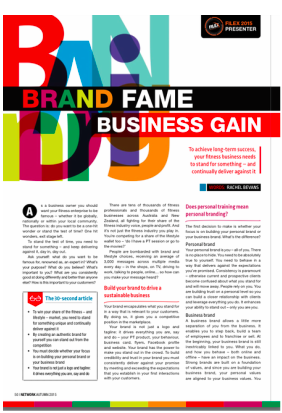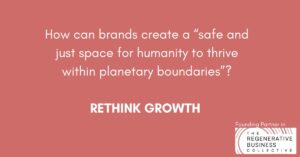Australian Fitness Network asked me to write this article for the run up to my FILEX2015 #InspiringGreatness session on Build your Brand. Build your Business. To find out more about FILEX or Australian Fitness Network, follow the hyperlinks.
To achieve long-term success, your fitness business needs to stand for something – and continually deliver against it.
As a business owner you should want your fitness enterprise to be famous – whether it be globally, nationally or within your local community. The question is: do you want to be a one-hit wonder or stand the test of time? One hit wonders, exit stage left.
To stand the test of time, you need to stand for something – and keep delivering against it, day in, day out.
Ask yourself: what do you want to be famous for, renowned as, an expert in? What’s your purpose? What do you believe? What’s important to you? What are you consistently good at doing differently and better than anyone else? How is this important to your customers?
There are tens of thousands of fitness professionals and thousands of fitness businesses across Australia and New Zealand, all fighting for their share of the fitness industry voice, people and profit. And it’s not just the fitness industry you play in. You’re competing for a share of the lifestyle wallet too – ‘do I have a PT session or go to the movies?’
People are bombarded with brand and lifestyle choices, receiving an average of 3,000 messages across multiple media every day – in the shops, on TV, driving to work, talking to people, online… so how can you make your message heard?
BUILD YOUR BRAND TO DRIVE A SUSTAINABLE BUSINESS
Your brand encapsulates what you stand for in a way that is relevant to your customers. By doing so, it gives you a competitive position in the marketplace.
Your brand is not just a logo and tagline: it drives everything you are, say and do – your PT product, your behaviour, business card, flyers, Facebook profile and website. Your brand has the power to make you stand out in the crowd. To build credibility and trust in your brand you must consistently deliver against your promise by meeting and exceeding the expectations that you establish in your first interactions with your customers.
DOES PERSONAL TRAINING MEAN PERSONAL BRANDING?
The first decision to make is whether your focus is on building your personal brand or your business brand. What’s the difference?
Personal brand
Your personal brand is you – all of you. There is no place to hide. You need to be absolutely true to yourself. You need to behave in a way that delivers against the expectations you’ve promised. Consistency is paramount – otherwise current and prospective clients become confused about what you stand for and will move away. People rely on you. You are building trust on a personal level so you can build a closer relationship with clients and leverage everything you do. It enhances your ability to stand out – only you are you.
Business brand
A business brand allows a little more separation of you from the business. It enables you to step back, build a team of employees and to franchise or sell. At the beginning, your business brand is still inextricably linked to you. What you do, and how you behave – both online and offline – have an impact on the business. Strong brands are built on a foundation of values, and since you are building your business brand, your personal values are aligned to your business values. You would expect the same values to be shared by any prospective employees and customers.
HOW DO YOU CREATE YOUR OWN BRAND?
Firstly, define what you stand for, what you do differently and better to anyone else, and how it is important to customers. Then behave in a way that’s consistent with your brand and delivers upon that ‘promise’.
The best way to illustrate this is to look at the case of a brand we all know, so let’s focus on Ford.
Ford encapsulates what its brand stands for in its strapline ‘Go further’. It is important to Ford’s customers for their money to ‘go further’ so they can ‘go further’ in their car journey and further in life.
Ford’s advertising communicates this promise to customers. Its cars deliver – they are reliable and enable you to go further with less fuel and less maintenance. Its service delivers – via customer service people who will go that step further to help you on your way.
While other car brands could also promise reliability and value for money, Ford has shown that it understands, and is aligned with, its customers’ needs and values by addressing them in its brand promise. Ford’s consistent behaviour over time, and throughout the customer’s brand experience, demonstrates that this promise is authentic, credible and trustworthy. With trust comes referral and repeat business.
LIVING YOUR BRAND
Living your brand consistently builds your reputation and your business. It’s a matter of authenticity. If you create a brand that doesn’t actually align with your values, it will only be a matter of time before the façade crumbles.
1. What you stand for
If you can come up with a four to six word strapline that encapsulates what you stand for, such as Ford’s ‘Go further’, then check for trademarks and consider trademarking it. Also check availability of URLs, Facebook pages and hashtags in case you want to create a campaign at a later date.
For personal use, put it on your wall or screen saver to keep reminding yourself what your brand stands for, and sense check everything you are, say and do.
2. Your brand identity
Your brand is more than a logo, it’s an identity.
Your logo should consist of a brand name, symbol and typeface that reflect what your brand stands for.
The rest of the visual identity is made up of:
-
Colour palette – primary, secondary
-
Imagery – style of photography, illustration
-
Font family – headings, body copy
-
Symbols and dividers.
You also need to address the first impression you make on people and your sensory identity:
-
What do you look like? Are you dressed in uniform? Is it clean and ironed?
-
What do you smell like? Type of hair gel, deodorant?
-
What do you sound like? Type of music/soundtrack used, volume?
Tone of voice:
-
What tone of voice do you use? Is it friendly, serious or both friendly and professional?
-
What language do you use when talking to someone, versus writing articles or social media posts?
Behaviour:
-
How should you act, both in person and online, with clients and other people? Think about what matters to your clients, as well as what you stand for. Reliability, consistency and commitment are commonly held values when it comes to customer service. Think carefully about what spreads. If it’s done or said in public, it is public.
-
How should you definitely not act? This is worth putting on your screen saver!
3. Your key messages
Focus on three or four key points that you want to communicate about your business, and then expand on them by backing the claims up with proof. Here’s an example:
Key point: ‘I am the most friendly and approachable trainer in Double Bay’
Proof: 9/10 of my clients approached me first
Proof: Double Bay News wrote of me as the friendliest trainer in the neighbourhood
Proof: My clients agree: ‘He is the friendliest, makes me feel at home’ J Bell
Then repeat, repeat, repeat. Not every point has to be on every piece of communication, but all the pieces together (business card, website and flyer) create a whole picture for the customer.
4. Your touch-points
You are the key one of these. You know your values and how you should look, smell, sound and behave. The same goes for any employees you may have.
Your communications should reflect what you stand for. If you stand for ‘Go further’, then your advertising, public relations editorials, social media, flyers, business cards and programs should reflect this.
Define your product, service and process. Just as Ford’s reflect ‘Go further’, so should yours embody your message.
Consider anything you use for work as reflecting or detracting from your brand – your studio or outdoor set-up, car, fitness equipment, the state of your iPad, mobile phone and even your pens – a broken biro ‘borrowed’ from the bank does not send the right message!
Last, but not least, pricing underpins your brand’s reputation for quality and credibility. Continual cost cutting seldom works as a long term strategy. Set your prices to reflect the quality of service you are delivering: brand fame isn’t won with a price fight.




